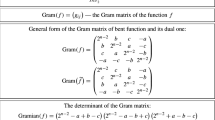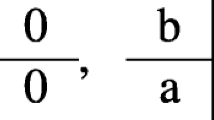Abstract
Bent functions are maximally nonlinear Boolean functions. They are important functions introduced by Rothaus and studied firstly by Dillon and next by many researchers for more than four decades. A systematic construction method of bent functions by modifying the support of Rothaus’s bent function was given in Su (IEEE Trans Inf Theory 66(5):3277–3291, 2020). In this paper, we give a further study on that construction method. Two more flexible construction methods of bent functions by modifying the support of Rothaus’s bent function are given respectively. The newly constructed bent functions contain the result in Su (2020), which is simply a special subclass of the newly constructed bent functions. The dual functions of these bent functions are determined. The methods of constructing self-dual bent functions are given. And the numbers of the newly constructed bent functions are also presented.
Similar content being viewed by others
References
Canteaut A., Charpin P.: Decomposing bent functions. IEEE Trans. Inf. Theory 49(8), 2004–2019 (2003).
Carlet C.: Two new classes of bent functions. In: Helleseth T. (ed.) Advances in CryptologyEUROCRYPT (Lecture Notes in Computer Science), vol. 765, pp. 77–101. Springer, Berlin (1994).
Carlet C.: On the secondary constructions of resilient and bent functions. In: Feng K., Niederreiter H., Xing C. (eds.) Proceedings of Workshop in Coding, Cryptography Combinatorics, pp. 3–28. Birkhauser, Basel (2004).
Carlet C.: Boolean functions for cryptography and error correcting codes. In: Crama Y., Hammer P.L. (eds.) Boolean Models and Methods in Mathematics, Computer Science, and Engineering, pp. 257–397. Cambridge University Press, Cambridge (2010).
Carlet C., Mesnager S.: Four decades of research on bent functions. Des. Codes Cryptogr. 78(1), 5–50 (2016).
Carlet C., Danielsen L.E., Parker M.G., Solé P.: Self-dual bent functions. Int. J. Inform. Coding Theory 1(4), 384–399 (2010).
Carlet, C., Helleseth, T., Kholosha, A., Mesnager, S.: On the dual of bent functions with \(2^r\) Niho exponents. In: Proceedings of IEEE ISIT, Aug (2011), pp. 703–707.
Carlet C., Zhang F., Hu Y.: Secondary constructions of bent functions and their enforcement. Adv. Math. Commun. 6(3), 305–314 (2012).
Danielsen L., Parker M., Solé P.: The Rayleigh quotient of bent functions. In: Cryptography and Coding, vol. 5921, pp. 418–432. Lecture Notes in Computer Science. Springer, Berlin (2009).
Dillon J.: Elementary Hadamard difference sets, Ph.D. dissertation, Department of Mathematics, University of Maryland, College Park, MD, USA (1974).
Dobbertin H.: Construction of bent functions and balanced Boolean functions with high nonlinearity. In: Fast Software Encryption, vol. 1008, pp. 61–74. Lecture Notes in Computer Science. Springer, Berlin (1994).
Hodz̆ć S., Pasalic E., Wei Y.: A general framework for secondary constructions of bent and plateaued functions, Des. Codes Cryptogr. 88, 2007–2035 (2020).
Kolomeec N.: Some general properties of modified bent functions through addition of indicator functions. Cryptogr. Commun. 13(6), 909–926 (2021).
Leander G., Mcguire G.: Construction of bent functions from near-bent functions. J. Comb. Theory A 116(4), 960–970 (2009).
MacWilliams F.J., Sloane N.J.A.: The Theory of Error-Correcting Codes. North-Holland, Amsterdam (1977).
Mesnager S.: Several new infinite families of bent functions and their duals. IEEE Trans. Inf. Theory 60(7), 4397–4407 (2014).
Mesnager S.: Further constructions of infinite families of bent functions from new permutations and their duals. Cryptogr. Commun. 8(2), 229–246 (2016).
Mesnager S., Zhang F., Yong Z.: On construction of bent functions involving symmetric functions and their duals. Adv. Math. Commun. 11(2), 347–352 (2017).
Rothaus O.S.: On ‘bent’ functions. J. Comb. Theory A 20(3), 300–305 (1976).
Su S.: Systematic methods of constructing bent functions and 2-rotation symmetric bent functions. IEEE Trans. Inf. Theory 66(5), 3277–3291 (2020).
Su S., Tang X.: Systematic constructions of rotation symmetric bent functions, 2-rotation symmetric bent functions, and bent idempotent functions. IEEE Trans. Inf. Theory 63(7), 4658–4667 (2017).
Tokareva N.: On the number of bent functions from iterative constructions: lower bounds and hypotheses. Adv. Math. Commun. 5(4), 609–621 (2011).
Zhang F., Pasalic E., Wei Y., Cepak N.: Constructing bent functions outside the Maiorana–McFarland class using a general form of Rothaus. IEEE Trans. Inf. Theory 63(8), 5336–5349 (2017).
Acknowledgements
The authors would like to thank the editor and the anonymous reviewers for their constructive comments and suggestions which improved the quality of the paper. This work is supported by the Key Scientific Research Project of Colleges and Universities in Henan Province (Grant No. 21A413003) and the National Natural Science Foundation of China (Grant No. 61502147).
Author information
Authors and Affiliations
Corresponding author
Additional information
Communicated by P. Charpin.
Publisher's Note
Springer Nature remains neutral with regard to jurisdictional claims in published maps and institutional affiliations.
Rights and permissions
Springer Nature or its licensor (e.g. a society or other partner) holds exclusive rights to this article under a publishing agreement with the author(s) or other rightsholder(s); author self-archiving of the accepted manuscript version of this article is solely governed by the terms of such publishing agreement and applicable law.
About this article
Cite this article
Su, S., Guo, X. A further study on the construction methods of bent functions and self-dual bent functions based on Rothaus’s bent function. Des. Codes Cryptogr. 91, 1559–1580 (2023). https://doi.org/10.1007/s10623-022-01169-2
Received:
Revised:
Accepted:
Published:
Issue Date:
DOI: https://doi.org/10.1007/s10623-022-01169-2




